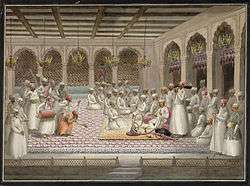Qawwali
Qawwali (Urdu: قوّالی (Nasta'liq); Punjabi: ਕ਼ੱਵਾਲੀ (Gurmukhi), قوّالی (Shahmukhi); Hindi: क़व्वाली (Devanagari); Bengali: কাওয়ালি (Bengali-Assamese)) is a form of Sufi Islamic devotional singing, originating from the Indian subcontinent, and notably popular in the Punjab and Sindh regions of Pakistan; in Hyderabad, Delhi and other parts of India, especially North India; as well as the Dhaka and Chittagong Divisions of Bangladesh.
| Part of a series on Islam Sufism |
|---|
|
List of sufis |
|
|
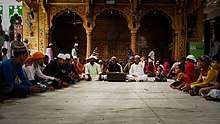
Originally performed at Sufi shrines or dargahs throughout South Asia, it gained mainstream popularity and an international audience in late 20th century. Qawwali music received international exposure through the work of the late Pakistani singers Aziz Mian, Nusrat Fateh Ali Khan and Sabri Brothers largely due to several releases on the Real World label, followed by live appearances at WOMAD festivals. Other famous Qawwali singers include Pakistan's Fareed Ayyaz & Abu Muhammad, Rahat Fateh Ali Khan, Badar Maindad, Rizwan & Moazzam Duo, the late Amjad Sabri and Bahauddin Qutbuddin. Most modern Qawwali singers including Ustad Nusrat Fateh Ali Khan and Fareed Ayyaz & Abu Muhammad belong to the famed 'Qawwal Bachon ka Gharana' school of Qawwali, which was based in Delhi.
Definition
Qaul (Arabic: قَوْل) is an "utterance (of the prophet)", Qawwāl is someone who often repeats (sings) a Qaul, Qawwāli is what a Qawwāl sings.
Origins
Delhi's Sufi saint Amir Khusrow of the Chisti order of Sufis is credited with fusing the Persian, Arabic, Turkish, and Indian traditions in the late 13th century in India to create Qawwali as we know it today.[1] The word Sama is often still used in Central Asia and Turkey to refer to forms very similar to Qawwali, and in India, Pakistan and Bangladesh, the formal name used for a session of Qawwali is Mehfil-e-Sama.
Originally, musical instrument use in Qawwali was prohibited. The following conditions were initially placed on Qawwali:[2]
“Sima’ (to listen to Qawwali) is permissible if a few conditions are met. The singer must be an adult and not a child or a female. The listener must only listen to everything in the remembrance of Allah. The words that are sung must be free from obscenity and indecency and they must not be void. Musical instruments must not be present in the gathering. If all these conditions are met, Sima’ is permissible.”
“...Someone complained to the Sultan of the Mashaa’ikh that some of the dervishes danced in a gathering where there were musical instruments. He said, they did not do good as something impermissible cannot be condoned.”
Moreover, such Sufi Saints, such as Nizamuddin Auliya, the teacher of the famous Sufi singer, Amir Khusrow, were quite blunt about the prohbition:
Musical instruments are Haram.
Eventually however, musical instrument use found its way into Qawwali and modern performers of musical Qawwali will justify their use of instruments by saying that the Sufi Saints do not stop them when they use them near their shrines.[2] Instruments such as Harmoniums, tabla and dholak are now common in many Qawwali parties.
Song content
| Music of Pakistan | |
|---|---|
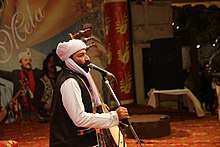 | |
| Genres | |
| Specific forms | |
| Religious music | |
| Ethnic music | |
| Other music | |
| Media and performance | |
| Music awards | Hum Awards Lux Style Awards Nigar Awards Pakistan Media Awards ARY Film Awards |
| Music charts | Patari Haftanama |
| Music festivals | All Pakistan Music Conference Lahore Music Meet Lok Virsa Mela |
| Music media | Magazines
Television
Internet |
| Nationalistic and patriotic songs | |
| National anthem | Qaumi Taranah |
| Regional music | |
| |
| Music of Bangladesh | |
|---|---|
 | |
| Genres | |
| Specific forms | |
| Religious music | |
| Ethnic music | |
| Traditional music | |
| Media and performance | |
| Music awards | |
| Music festivals | |
| Music media | Radio
Television Internet |
| Nationalistic and patriotic songs | |
| National anthem | Amar Shonar Bangla |
| Other | Notuner Gaan (National March) Ekusher Gaan (Ode to the Language Movement) |
| Regional music | |
| Related areas | |
| Other regions | |
| Music of India | |
|---|---|
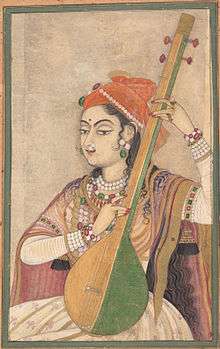 A Lady Playing the Tanpura, c. 1735 (Rajasthan) | |
| Genres | |
| Traditional
Modern | |
| Media and performance | |
| Music awards | |
| Music festivals | |
| Music media | |
| Nationalistic and patriotic songs | |
| National anthem | Jana Gana Mana |
| Regional music | |
| |
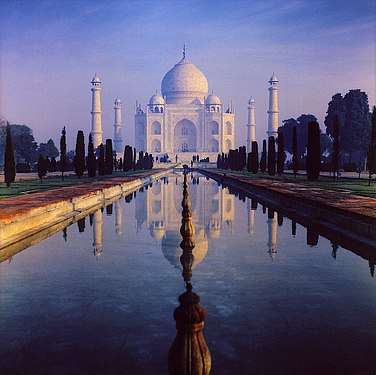 |
| Part of a series on |
| Islamic culture |
|---|
| Architecture |
| Art |
|
| Dress |
| Holidays |
|
| Literature |
|
| Music |
| Theatre |
|
The songs which constitute the qawwali repertoire are primarily in Persian, Urdu, Hindi, Bengali and Punjabi.[5] There are some in Persian from the Mughal era, and a smattering in Saraiki and dialects of north India like Braj Bhasha and Awadhi.[6][7] There is also qawwali in some regional languages but the regional language tradition is relatively obscure. Also, the sound of the regional language qawwali can be totally different from that of mainstream qawwali. This is certainly true of Chhote Babu Qawwal, whose style of singing is much closer to the Bengali Baul music than to the qawwali of Nusrat Fateh Ali Khan, for example.
The poetry is implicitly understood to be spiritual in its meaning, even though the lyrics can sometimes sound wildly secular, or outright hedonistic. The central themes of qawwali are love, devotion and longing (of man for the Divine).
Qawwalis are classified by their content into several categories:
- A hamd (حمد), Arabic for praise, is a song in praise of Allah. Traditionally, a qawwali performance starts with a hamd.
- A na`at (نعت), Arabic for description, is a song in praise of Muhammad. The opening hamd is traditionally followed by a naat.
- A manqabat (plural manaqib, مناقب, which means characteristics) is a song in praise of either Imam Ali or one of the Sufi saints. Manaqib in praise of Ali are sung at both Sunni and Shi'a gatherings. If one is sung, it will follow right after the naat. There is usually at least one manqabat in a traditional programme.
- A marsiya (مرثية), Arabic for lamentation for a dead person, is a lamentation over the death of much of Imam Husayn family in the Battle of Karbala. This would typically be sung only at a Shi'a gathering.
- A ghazal (غزل), Arabic for love song, is a song that sounds secular on the face of it. There are two extended metaphors that run through ghazals—the joys of drinking and the agony of separation from the beloved. These songs feature exquisite poetry, and can certainly be taken at face value, and enjoyed at that level.[8] In fact, in Pakistan and India, ghazal is also a separate, distinct musical genre in which many of the same songs are performed in a different musical style, and in a secular context. In the context of that genre, the songs are usually taken at face value, and no deeper meaning is necessarily implied. But in the context of qawwali, these songs of intoxication and yearning use secular metaphors to poignantly express the soul's longing for union with the Divine, and its joy in loving the Divine. In the songs of intoxication, "wine" represents "knowledge of the Divine", the "cup-bearer" (saaqi) is God or a spiritual guide, the "tavern" is the metaphorical place where the soul may (or may not) be fortunate enough to attain spiritual enlightenment. (The "tavern" is emphatically not a conventional house of worship. Rather, it is taken to be the spiritual context within which the soul exists.) Intoxication is attaining spiritual knowledge, or being filled with the joy of loving the Divine. In the songs of yearning, the soul, having been abandoned in this world by that cruel and cavalier lover, God, sings of the agony of separation, and the depth of its yearning for reunion.
- A kafi is a poem in Punjabi, Seraiki or Sindhi, which is in the unique style of poets such as Sultan Bahoo, Shah Hussain, Bulleh Shah and Sachal Sarmast. Two of the more well-known Kafis include Ni Main Jana Jogi De Naal and Mera Piya Ghar Aaya.
- A munajaat (مناجاة), Arabic for a conversation in the night or a form of prayer, is a song where the singer displays his thanks to Allah through a variety of linguistic techniques. It is often sung in Persian, with Mawlana Jalāl-ad-Dīn Rumi credited as its author.
Composition of a qawwali party
A group of qawwali musicians, called a party (or Humnawa in Urdu), typically consists of eight or nine men including a lead singer, one or two side singers, one or two harmoniums (which may be played by the lead singer, side singer or someone else), and percussion. If there is only one percussionist, he plays the tabla and dholak, usually the tabla with the dominant hand and the dholak with the other one (i.e. a left-handed percussionist would play the tabla with his left hand). Often there will be two percussionists, in which case one might play the tabla and the other the dholak. There is also a chorus of four or five men who repeat key verses, and who aid percussion by hand-clapping.
The performers sit cross-legged on the ground in two rows — the lead singer, side singers and harmonium players in the front row, and the chorus and percussionists in the back row.
Before the fairly recent introduction of the harmonium, qawwalis were usually accompanied by the sarangi. The sarangi had to be retuned between songs; the harmonium didn't, and was soon preferred.
Women used to be excluded from traditional Muslim music, since they are traditionally prohibited from singing in the presence of men. These traditions have changed, however, as is evident by the popularity (and acceptance) of female singers such as Abida Parveen. However, qawwali has remained an exclusively male business. There are still no mainstream female qawwals. Although kafi singer Abida Parveen has increasingly incorporated qawwali techniques into her performances, she is still not considered a qawwali singer.[9]
Musical structure of Qawwali
Songs are usually between 15 and 30 minutes long. However, the longest commercially released qawwali runs slightly over 115 minutes (Hashr Ke Roz Yeh Poochhunga by Aziz Mian Qawwal). The qawwali maestro Nusrat Fateh Ali Khan has at least two songs that are more than 60 minutes long.
Qawwalis tend to begin gently and build steadily to a very high energy level in order to induce hypnotic states both among the musicians and within the audience. Almost all Qawwalis are based on a Raga from the Hindustani classical music tradition. Songs are usually arranged as follows:
- They start with an instrumental prelude where the main melody is played on the harmonium, accompanied by the tabla, and which may include improvised variations of the melody.
- Then comes the alap, a long tonal improvised melody during which the singers intone different long notes, in the raga of the song to be played.
- The lead singer begins to sing some preamble verses which are typically not part of the main song, although thematically related to it. These are sung unrhythmically, improvised following the raga, and accompanied only by the harmonium. After the lead singer sings a verse, one of the side singers will repeat the verse, perhaps with his own improvisation. A few or many verses will be sung in this way, leading into the main song.
- As the main song begins, the tabla, dholak and clapping begin. All members join in the singing of the verses that constitute the refrain. The lyrics of the main verses are never improvised; in fact, these are often traditional songs sung by many groups, especially within the same lineage. However, the tunes are subtly improvised within the framework of the main melody. As the song proceeds, the lead singer or one of the side singers may break out into an alap. Nusrat Fateh Ali Khan also popularized the interjection of sargam singing at this point. The song usually builds in tempo and passion, with each singer trying to outdo the other in terms of vocal acrobatics. Some singers may do long periods of sargam improvisation, especially alternating improvisations with a student singer. The songs usually end suddenly.
The singing style of qawwali is different from Western singing styles in many ways. For example, in words beginning with an "m", Western singers are apt to stress the vowel following the "m" rather than the "m" itself, whereas in qawwali, the "m" will usually be held, producing a muted tone. Also in qawwali, there is no distinction between what is known as the chest voice and the head voice (the different areas that sound will resonate in depending on the frequency sung). Rather, qawwals sing very loudly and forcefully, which allows them to extend their chest voice to much higher frequencies than those used in Western singing, even though this usually causes a more noisy or strained sound than would be acceptable in the West.
Traditional sequence of a Chishtiya Sufi Order qawwali performance
- Instrumental: This is supposed to be the announcement of the arrival of Moinuddin Chishti, as Sufi believes their saints are free of time-space. Also that Nabi, Siddiq, Shaheed, and Saleh category of faithfuls are never dead, just gone into some other state from where they visit whenever they are mentioned, especially if there is a function in their honor.
- Hamd
- Na`at
- Manqabat Ali
- Manqabats in praise of Sufi saints
- Manqabat Shaikh: Praise of the Shaikh/Pir if the performance is at an Urs celebration
- Rang or Badhawa: If it is an Urs performance, then it is usually Rang, a poem by Amir Khusro. The audience is often asked to stand when the Rang is sung. If it is the Shaikh's birthday, it is usually the Badhawa.
Notable Qawwals of the past 70 years
- Aziz Mian
- Badar Ali Khan, aka Badar Miandad
- Bahauddin Qutbuddin
- Fateh Ali Khan
- Habib Painter
- Iqbal Hussain Khan Bandanawazi
- Jaafar Husain Khan Badauni
- Munshi Raziuddin
- Nusrat Fateh Ali Khan
- Qari Muhammad Saeed Chishti
- Sabri Brothers
Current and recent Qawwals
- Ateeq Hussain Khan
- Abdullah Manzoor Niazi
- Faiz Ali Faiz
- Fareed Ayaz
- Mehr Ali Sher Ali
- Nizami Bandhu
- Rahat Fateh Ali Khan
- Rizwan Muazzam
- Waheed and Naveed Chishti
- Warsi Brothers
See also
References
- "'Aaj rang hai' - Qawwali revisited". TwoCircle.net. Retrieved 8 March 2013., Retrieved 16 September 2015
- Hussain, Zahid (22 April 2012). "Is it permissible to listen to Qawwali?". TheSunniWay. Retrieved 12 June 2020.
- Muhammad bin Mubarak Kirmani. Siyar-ul-Auliya: History of Chishti Silsila (in Urdu). Translated by Ghulam Ahmed Biryan. Lahore: Mushtaq Book Corner.
- Nizamuddin Auliya (31 December 1996). Fawa'id al-Fu'aad: Spirtual and Literal Discourses. Translated by Z. H. Faruqi. D.K. Print World Ltd. ISBN 9788124600429.
- Monograph Series, Issues 20-23. Center for South and Southeast Asia Studies, University of California. 1979. p. 124.
Qawwali texts exist in Persian, Urdu and Hindi.
- "Bollywood Reinvents the Qawwali – With a Vengeance". The Day After: An International Illustrated Newsmagazine of India. Archived from the original on 26 January 2009. Retrieved 23 February 2007.
- "Delhi's Qawwal Bachchon ka Gharana lights up Ramadan night at T2F". Daily Times: Leading News Resource of Pakistan. Retrieved 23 February 2007.
- Manuel, Peter Lamarche (1993). Cassette culture: popular music and technology in north India. U of Chicago P. pp. 124. ISBN 978-0-226-50401-8. Retrieved 3 April 2010., Google Books Article, Retrieved 17 September 2015
- Abbas, Shemeem Burney (2003). Abbas, Shemeem Burney. The female voice in sufi ritual: devotional practices of Pakistan and India. University of Texas Press.
External links
- BBC Radio 3 Audio (45 minutes): The Nizamuddin shrine in Delhi. Accessed 25 November 2010.
- BBC Radio 3 Audio (45 minutes): A mahfil Sufi gathering in Karachi. Accessed 25 November 2010.
- Origin and History of the Qawwali, Adam Nayyar, Lok Virsa Research Centre, Islamabad. 1988.
